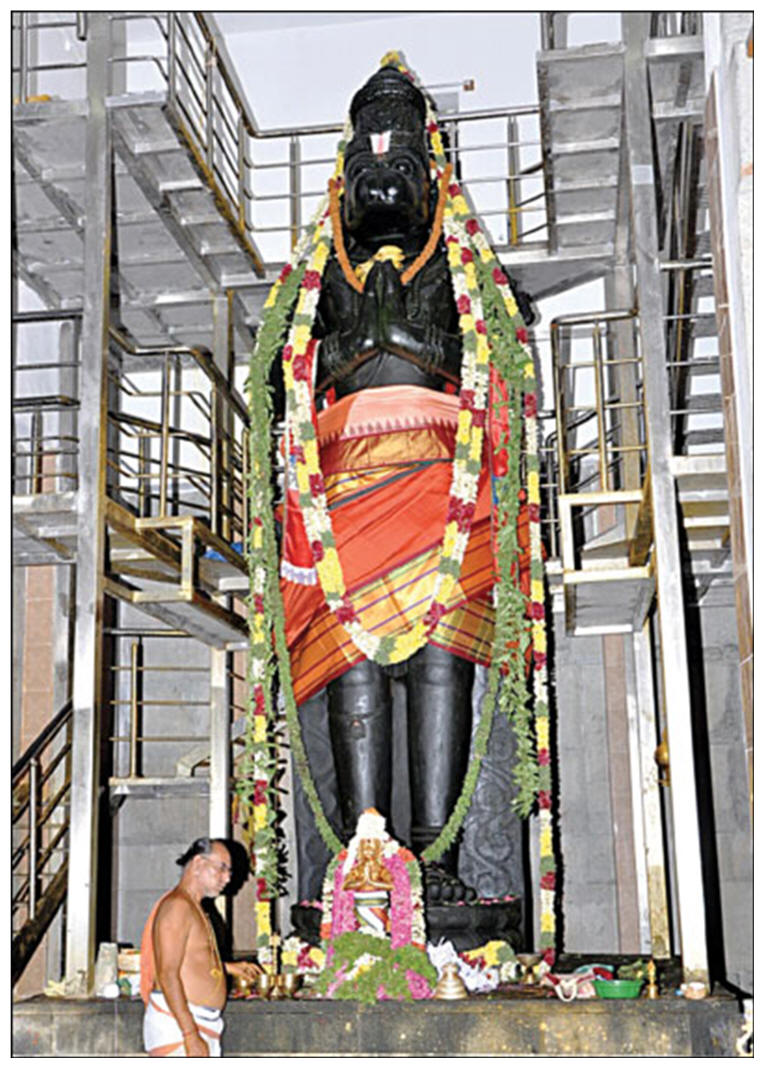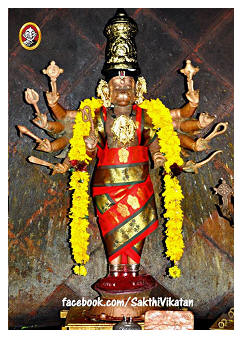HANUMAN
Hanuman is the son of Vāyu (Wind-god) and Anjana (añjanā, an apsara =
அப்ஸரஸ் apsaras,= A class of celestial nymphs.), the first and foremost
devotee of Rama. He is the model of strength, endurance, valor, will
power, dedication, and Brahmacharya. He mastered Vedas. He is the
demigod of the people, a friend of Rama, supporter of Dharma, a paragon
of service, humility and virtue, a hero to Sita, Rama and devotees, a
warrior among Vanaras (monkey-faced humanoids), an ambassador to Ravana,
a consummate grammarian, a master of his senses (Indriya Nigraha), a
giver of hope to Sita and Rama, a hero to all… He is Hanuman (the
Heavy-jawed), Anjaneya (Matronymic), Māruti (Patronymic. Marutan =
wind-god), and Anili (Patronymic. அனிலம் aṉilam= Wind-god).
He is always depicted with Rama in a pose of humility or by himself.
From 16th century onwards after the invasion by Muslims, Hanuman was
depicted in tall structures.
Hanuman means ‘Heavy-Jawed.’ He has ‘a short neck, red round face, sharp
white fangs, a mane like Aśoka flowers, a tail like Indra’s banner, and
able to expand as large as a mountain.’ Once he was devoured by a
sea-monster and expelled via the mouth or the ear of the monster.
|
|

|
When he took a jump from the high point of Mahendra Hill to Lanka,
Surasa the mother of Nagas (Snake Tribe) and Simhika, the daughter of
Diti (the mother of Daityas-Anti-gods) tried to impede his jump to Sri
Lanka. He defeated them and took the form of a cat and entered the
palace grounds of Ravana. Once he came to the gardens, he resumed his
original form, wandered around looking for Sita, destroyed the gardens,
and saw her in Ashoka grove. Sita was not sure of who he was. Hanuman
produced the signet ring of Rama and convinced Sita of his noble
intentions. He promised to return to Lanka with Rama and his troops. The
guards of Ravana seeing the devastation of the gardens, caught and
handed Hanuman to Indrajit who took him to the court of Ravana.
Hanuman sat on his coiled tail in the court. When Ravana raised his
throne a notch above Hanuman, Hanuman raised the height his long-tail
coil one notch above Ravana’s throne. Ravana wanted to kill him
immediately. Indrajit prevailed against it, wrapped the tail with
oil-soaked rags and set it on fire. Indrajit paraded him on the streets
of Sri Lanka. Sita invoked the god of Fire Agni to protect the tail from
the fire. Hanuman set the city on fire. On his way back to Rama, Hanuman
extinguished the fire by splashing his tail in the waters of the ocean.
He went to Rama and informed him about finding Sita and his other
exploits in Lanka.
A battle ensued between Rama, Lakshmana, Hanuman on one side and his
troops on one side and Ravana and his minions.
|
|

|
When Rama was exhausted on the battlefield, Hanuman, being the son of
Wind-god, flew to Himalayas, brought the whole mountain on which the
healing, invigorating and resurrecting herb (Sanjivini) grew and with
the herb the physicians brought Rama back to his fighting self. The herb
also resurrected Lakshmana back to life, who died in the battle. A
grateful Rama blessed Hanuman with a long life. (Arjuna’s banner had the
image of Hanuman on it.)
Kālanemi was a Rākṣasa and an uncle of Rāvaṇa, who wanted Hanuman the
ally of Rama to die. Kālanemi impersonated as a recluse and invited
Hanuman to his hermitage as a guest. Hanuman’s natural instincts
prevented him from accepting the invitation and instead he went to a
pond to bathe. A crocodile caught his leg and dragged him deep into the
water. Hanuman killed it and by preordination released the crocodile
from its curse by Dakṣa. An Apsaras emerged from the body, thanked
Hanuman for enabling the release from the curse, and warned him of
Kālanemi’s nefarious intent. Hanuman went to the hermitage, seized
Kālanemi and tossed him so high he landed in Sri Lanka before the throne
of Ravana. He killed scores of charging Ghandarvas (celestial
musicians), the compatriots of Kālanemi.
He is the patron of itinerant wrestlers, acrobats… Though a confirmed
inveterate bachelor, devotees pray to him for progeny.
The ancestors expressed their unhappiness in a dream by Hanuman. He did
not understand its import. He went to the son of Vasiṣtha and asked him
for an explanation. He said, “Hunger struck your ancestors. You must pay
the debt by offering something (śrāddha).” Hanuman paid his debt but the
unhappy ancestors came back in the dream.
|
|

|
Hanuman somehow knew the import (behind the dreams). He realized what
the worrying ancestors were trying to tell: “Hanuman, you offer oblation
to us in a proper manner. After your demise, who will offer oblations to
us?
Knowing the unhappiness and its cause, Sita Devi said, “Hanuman, don’t
be disheartened. Go to Kishkinda and bring back a bride. I will conduct
the wedding ceremony. Your progeny will perform śrāddha for the
ancestors. Hanuman left for Kishkinda and explained the situation to
Sugriva.
Sugriva sent him south to Kicchit country to see princess Cilymba and
marry her.
Hanuman went to the country, wherein the palace guard took him to
princess Cilymba. Hanuman presented his case to the princess. She looked
at him up and down and came to know all that should be known about
Hanuman from what he said. She said to Hanuman, “What and how much do
you know about the intricacies of love. If I were to desire a pearl
necklace, how would you deliver it to me? If I were to become
uncooperative and refused to eat, what will you do?” She asked a litany
of other questions.
|
|

|
Hanuman answered her questions by saying, “I am unfamiliar with the
principles of love. If I ask Sugriva, he will familiarize me with it. I
will get the pearl necklace from Sita Devi. If you stop eating, I will
use my iron-like fingers and force-feed you. Don’t make any delay. In
Ayodhya, Sita Devi is waiting to receive you.
Cilymba gave out a laughter and said, “You have no idea about love. Send
Sugriva to me.” Insulted by her, Hanuman forged forward but was stopped
and tied by the palace guards.
Cilymba ordered the guards, “Don’t leave this monkey alone. Cut off 12
inches of his tail and throw it away.” That moment, Hanuman meditated on
Rama, the ties stretched and broke, and his body grew up like Himalaya
mountain. Hanuman leaped, caught Cilymba by her hair and flew in the
sky.
As he was flying, the Ashta dikpalas (8 guardians of directions) and
Vidyadharas gossiping about the imminent end of bachelorhood of Hanuman
asked him, Maruthi, “We like to see the women you are carrying.” Hanuman
emitted a loud noise, which sent them scattering and disappearing in the
clouds.
Cilymba begged him to forgive her. Hanuman’s grip was tight. As Hanuman
was flying fast, he saw Sugriva playing in the Tungabhadra river with
his wives. That’s it! Time to drop her.
He dropped Cilymba from the sky on the shoulders of Sugriva and flied
faster than before.
|
|
 |
Sita Devi was perplexed as Hanuman returned empty-handed and said to
him,” O child, what happened, where is the girl?”
Hanuman with bowed head said, “Mother, she did not accept me. I carried
and gave her to Sugriva. In this wide world, god gave me a small heart.
You and Ramachandra have fully occupied it. There is no place for anyone
else.” So, saying, he asked for a boon.
“Mother! You must offer your blessings to me so I live long to repay the
debt to my ancestors and perform Sraddha to them. Sita Devi smiled and
said, “Hanuman, so is your desire; so, things will happen.” Happy became
Hanuman, lifted his hands high and roared, “Jaya Sitaram.”
|